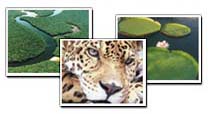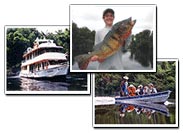|
Ads by Google
The Amazon
Read also: Travel to Amazon
Amazon is usually defined as the area covered by the river Amazon and its affluents; it's the biggest basin in the world, with about 6,500,000 km2, of which 4,750,000 km2 are in Brazil. The two largest Brazilian States, Amazonas and Pará, as well as several other smaller States, are completely covered by the Amazon.
The Amazon has equatorial climate, very hot and humid; average temperature is above 25 C, and difference from the hottest to the coldest month is under 2 C; annual precipitation is over 1,500 mm.
 Water is abundant, with many permanent rivers; large regions are flooded most of the year (these lands are called igapos); there is a grid of small channels (called igarapes) connecting the rivers.
Water is abundant, with many permanent rivers; large regions are flooded most of the year (these lands are called igapos); there is a grid of small channels (called igarapes) connecting the rivers.
Fertility of the soil is variable, but usually specific to a given ecossystem. That means that the Amazon has low agricultural potential (men can not decide what would flourish in a given part of Amazon; only nature can do it), but the the existant vegetation is of uncomparable diversity, developed by nature over the course of the centuries: trees (including many noble timber, object of greed for many and one of the main reasons of devastation of the forest), epyphitas, thousands of plants, many of which not yet classified (and where, according to pharmacologists, can be found active principles for inumerous diseases).
The fauna is the characteristic of the closed equatorial jungle; the jaguar or onca is the biggest felideo (bigger animals, like elephants and giraffes, need ample open space - like the African savanahs - to move and survive); other mamals include primates, cervides, and big rodents, like antas and capivaras; there are several birds, particularly macaws and similars (the largest number of birds in the world is not in Amazon, but in its neighbour
Pantanal); also, Amazon is house for the biggest collection of insects on Earth.
History. By the Treaty of Tordesillas, most of the region would originally belong to Spain. However, some factors caused the Portuguese to settle in the area during the centuries 16 through 18, such as: the invasion by the French of the region of Maranhao; the sixty years of unified kingdom Portuguese-Spanish; the missions of the jesuits (who, at the peak, had 50,000 indians under their tuition).
The Portuguese (and, later on, the Brazilians), however, didn't explore much of the region; a few cities were founded (like Belem, in 1621), to guarantee the possession, but only small cultures of cotton, tobacco and others were implanted. In the century 19, some cattle farms took the clearance spaces in the forest.
 During the turn to the 20th century, the region saw an economic boom: the automotive industry was growing quickly, and the tires were built with rubber from the Amazon. However, the exploration was extremely predatory, and based on conflicts between seringueiros (peasants who extracted the liquid rubber from the trees, called seringueiras) and the seringalistas (people who bought the rubber for later trading). The region saw a quick growth (Manaus became one of the biggest Brazilian cities; some of the biggest monuments of the city, like the luxurious theater, date back to this epoch), but which lasted shortly (the competition from other countries, especially from souther Asia, was fatal) and left many failures and years of stagnation.
During the turn to the 20th century, the region saw an economic boom: the automotive industry was growing quickly, and the tires were built with rubber from the Amazon. However, the exploration was extremely predatory, and based on conflicts between seringueiros (peasants who extracted the liquid rubber from the trees, called seringueiras) and the seringalistas (people who bought the rubber for later trading). The region saw a quick growth (Manaus became one of the biggest Brazilian cities; some of the biggest monuments of the city, like the luxurious theater, date back to this epoch), but which lasted shortly (the competition from other countries, especially from souther Asia, was fatal) and left many failures and years of stagnation.
In the second half of the century 20, international rumours about internationalization of the Amazon start to appear (Encyclopedia Britannica mentions Unesco, in 1945, and the Hudson Institute, in 1961, as sponsors of such ideas).
In response, the Brazilian government adopted plans to integrate the Amazon to the rest of the country.
Roads were open across the forest, like the Belem-Brasilia, Brasilia-Acre and the Transamazonica, which cuts the forest from West to East;these roads suffered with the lack of maintenaince, and the forest is claiming back a good part of them.
In 1967, a Free Zone was created in Manaus, in an attempt to develop the economy of the region. Industries established here have several tax exemptions, but these haven't been enough.
Nowadays, the Amazon is one of the main ecological reserves in the world.
Economical exploration of the region is not as planned and careful as it should be, and despite of the efforts of Brazilian authorities, much of the activity in the area is illegal.
Large vegetation areas are devastated
(often, by means of criminal fires) to explore timber (which is smuggled to richer countries) and clear space for cattle, small plantations and mineral explorations. Much of these activities are conducted by the poor locals (who don't have many other options to make a living), at service of or exploited by richer intermediaries which eventually profit by selling Amazon goods in the big cities.
Ecologic conscience is growing in Brazil. Action from Brazilian authorities and non-government groups are more and more common and effective. Visit
IBAMA, the Institute for Enviroment issues.
Ecologic tourism is incipient (mostly directed to foreigner clients), but growing.
The issue of Indians is in evidence. Large reserves have been created, but conflicts are still common.
Scientists (individuals and corporations) have more and more conducting studies about the Amazon. Brazilian scientists claim for more resources, but the Brazilian government (biggest funder of scientific researches in Brazil) faces severe financial problems. Several foreigner missions (individuals and institutionals) are official, but
bio-piracy is more common.
The borders in Amazon have been defined since the beginning of the century 20, but sovereignity issues have been raising again lately. The border areas are sparsefully inhabited, which facilitates invasions by guerrilla and drug traffic groups, notably from Colombia. Brazil has recently implanted a
surveillance system, but it's still to be seen how effective it will be to control movements and activies in such a large area as the Amazon.
Back to Top
|
|